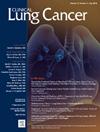Metrics for Perioperative Exercise in Patients Undergoing Lung Cancer Resection: A Systematic Review
IF 3.3
3区 医学
Q2 ONCOLOGY
引用次数: 0
Abstract
Perioperative exercise interventions have been shown to mitigate morbidity associated with lung resection. While these interventions have established a role in this patient population, there has been little discussion regarding which metrics are used to standardize perioperative exercise interventions. A better understanding of these metrics is needed to define best practices and ensure interventions are reproducible. A systematic review of the literature was performed using CINAHL, PubMed/MEDLINE, and SCOPUS. The initial review yielded a total of 3456 results. After review of titles and abstracts, 119 studies remained. The included studies underwent detailed review of the manuscript and 29 were found to meet the inclusion criteria for the review. A total of 29 studies were selected for inclusion. Included studies were completed on adult patients with diagnosis of lung cancer who underwent lung resection surgery and participated in a standardized exercise intervention before or after their surgery. The most common metrics used to grade exercise interventions were percent maximal workload (%Wmax) based on preoperative cardiopulmonary exercise testing (CPET), which was used in 41% of included studies, and symptom limited Borg rating of perceived exertion, which was used in 38% of included studies. There was significant variation in metrics used for tracking perioperative exercise interventions. Standardization of validated metrics for perioperative exercise interventions, specifically using percent of maximal workload and the Borg scale, would impact the ability to compare future studies and the effectiveness of exercise interventions.
肺癌切除术患者围手术期运动的指标:一项系统综述。
围手术期运动干预已被证明可以减轻与肺切除术相关的发病率。虽然这些干预措施在这一患者群体中已经确立了作用,但关于使用哪些指标来标准化围手术期运动干预措施的讨论很少。需要更好地了解这些指标,以确定最佳做法并确保干预措施的可重复性。使用CINAHL、PubMed/MEDLINE和SCOPUS对文献进行系统综述。初步审查共产生3456项结果。在对标题和摘要进行审查后,仍有119项研究。纳入的研究对手稿进行了详细的审查,发现29项研究符合审查的纳入标准。共纳入29项研究。纳入的研究是针对接受肺切除术并在术前或术后参加标准化运动干预的成年肺癌患者完成的。用于对运动干预进行分级的最常用指标是基于术前心肺运动测试(CPET)的最大工作量百分比(%Wmax), 41%的纳入研究使用了该指标,38%的纳入研究使用了感知运动的症状限制博格评分。用于跟踪围手术期运动干预的指标存在显著差异。围手术期运动干预的标准化验证指标,特别是使用最大工作量百分比和Borg量表,将影响比较未来研究和运动干预有效性的能力。
本文章由计算机程序翻译,如有差异,请以英文原文为准。
求助全文
约1分钟内获得全文
求助全文
来源期刊

Clinical lung cancer
医学-肿瘤学
CiteScore
7.00
自引率
2.80%
发文量
159
审稿时长
24 days
期刊介绍:
Clinical Lung Cancer is a peer-reviewed bimonthly journal that publishes original articles describing various aspects of clinical and translational research of lung cancer. Clinical Lung Cancer is devoted to articles on detection, diagnosis, prevention, and treatment of lung cancer. The main emphasis is on recent scientific developments in all areas related to lung cancer. Specific areas of interest include clinical research and mechanistic approaches; drug sensitivity and resistance; gene and antisense therapy; pathology, markers, and prognostic indicators; chemoprevention strategies; multimodality therapy; and integration of various approaches.
 求助内容:
求助内容: 应助结果提醒方式:
应助结果提醒方式:


